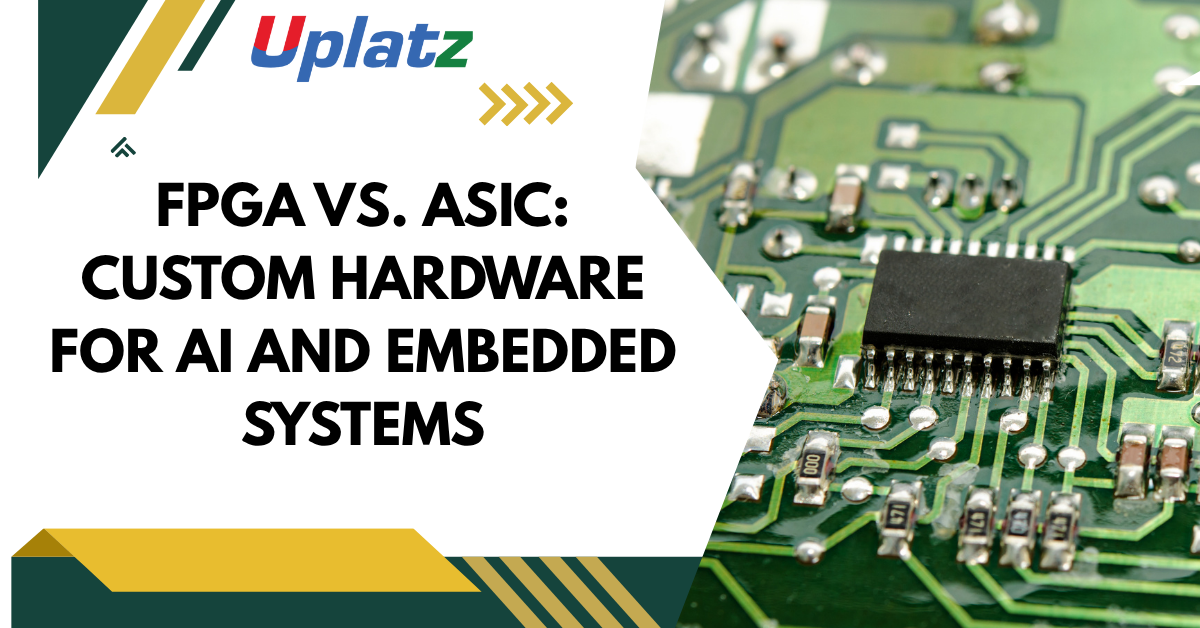FPGA vs. ASIC: Custom Hardware for AI and Embedded Systems
In designing AI accelerators and embedded systems, the choice between Field-Programmable Gate Arrays (FPGAs) and Application-Specific Integrated Circuits (ASICs) hinges on trade-offs in flexibility, performance, power, cost, and time-to-market. This report examines their architectures, development processes, performance characteristics, cost models, and ideal use cases to guide hardware decisions.

- Architectural Foundations
1.1 FPGA Architecture
FPGAs consist of an array of configurable logic blocks (CLBs), programmable interconnects, embedded memory (Block RAM), DSP slices, and I/O blocks. After manufacturing, designers load a “bitstream” to map HDL-described logic onto the fabric. This reprogrammable nature enables post-deployment updates and rapid prototyping.
1.2 ASIC Architecture
ASICs are custom-designed silicon chips tailored for a specific function. Their transistor layouts, interconnects, and I/O structures are fixed at fabrication, eliminating the overhead of programmability. ASICs achieve superior efficiency by optimizing data paths, minimizing area, and integrating specialized units (e.g., neural processing cores).
- Development Workflow
| Phase | FPGA Flow | ASIC Flow |
| Design Entry | HDL or high-level synthesis; rapid iterations | HDL; extensive specification |
| Verification | Behavioral & hardware-in-loop testing | Multi-stage simulation, formal, physical verification |
| Implementation | Synthesis → place & route → bitstream | RTL → gate level → floorplanning → routing |
| Tape-out/Programming | Minutes from design change | Mask generation → fabrication (6–24 months) |
| NRE (Non-recurring) | Low (designer tools only) | High (mask sets, fab setup) |
FPGA projects complete in weeks to months without mask costs, while ASICs demand significant NRE and a lead time up to two years.
- Performance & Power
3.1 Throughput & Latency
ASICs operate at clock rates 3–5× higher than FPGAs and achieve 5–10× greater throughput for equivalent logic owing to custom routing and minimized parasitic delays. FPGA performance gaps narrow in designs leveraging specialized DSP or AI blocks, but ASICs retain absolute speed advantages.
3.2 Power Efficiency
Custom ASICs consume 5–10× lower dynamic power and exhibit significantly reduced static leakage compared to FPGAs, thanks to tailored transistor sizing and removal of unused circuitry. In data centers, migrating from FPGA to ASIC cores cut power by nearly 87%, boosting energy efficiency by 3.5×.
- Cost Analysis
| Cost Aspect | FPGA | ASIC |
| NRE | $25 K–$600 K | $2 M–$15 M+ |
| Unit Cost (Low Volume) | $5–$5 000+ | $10–$100+ |
| Unit Cost (High Volume) | Remains high | Drops below $1 |
| Breakeven Volume | Typically > 5 000 units | Favorable at high volumes |
High-volume ASIC production amortizes NRE, delivering lower per-unit costs. Conversely, FPGAs avoid mask expenses, making them ideal below the 5 000–50 000 unit crossover point.
- Use Cases & Recommendations
5.1 When to Choose FPGA
- Rapid Prototyping & R&D: Quick iterations and field updates without hardware respin.
- Evolving Standards: Support for changing protocols in telecommunications or IoT.
- Low/Mid-Volume Products: Volumes below ASIC breakeven.
- Time-to-Market Critical: Products requiring aggressive launch schedules.
5.2 When to Choose ASIC
- Mass Production: High volumes where per-unit savings outweigh NRE.
- Performance-Critical AI: Inference engines demanding maximum throughput and low latency.
- Power-Sensitive Designs: Battery-operated devices where energy budget is paramount.
- Security & Reliability: Hardware-level IP protection and rigorous qualification.
5.3 Hybrid & Structured ASICs
Structured or platform ASICs bridge FPGA and full-custom ASIC: they reuse a common base, requiring only interconnect customization. This yields lower NRE and faster time-to-market than cell-based ASICs, with better performance and cost than FPGAs.
- Industry Examples
- AI Accelerators: Google’s TPUs (ASICs) deliver tens of teraops per second with 8-bit matrix engines, optimized for inference at 40 W TDP.
- Edge AI & IoT: FPGAs accelerate deep reinforcement learning and network offload, offering up to 346× speedups over GPUs in dynamic environments.
- Automotive ADAS: Early FPGA-based driver-assist prototypes transition to ASICs for production, reducing unit cost by 60% and power by 75%.
- Conclusion
The FPGA vs. ASIC decision is not binary but driven by application requirements, production volume, development budget, and performance targets. FPGAs excel in flexibility and speed-to-market, while ASICs dominate high-volume, power-efficiency, and performance-critical domains. Hybrid approaches and structured ASICs further blur distinctions, empowering designers to optimize across the hardware continuum.
